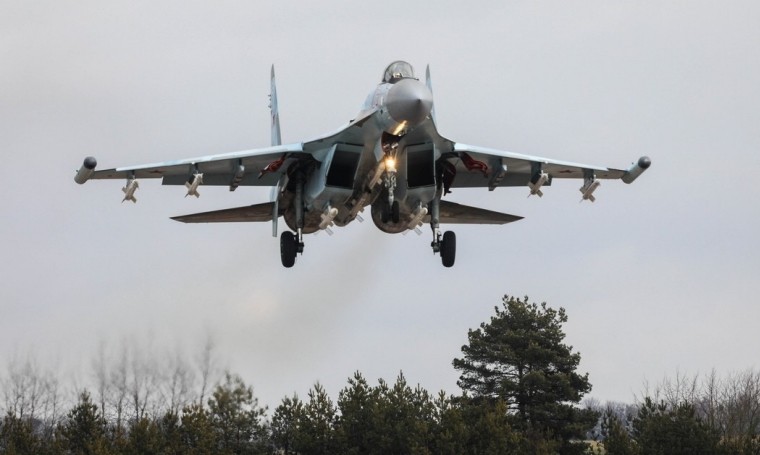While the red stars on the aircraft of the Russian Aerospace Forces, or VKS, have not been very visible in recent months, Russia’s air force remains largely intact despite its grinding war in Ukraine, according to independent analysis and official comments.
The fighting in Ukraine has been dominated by artillery exchanges, and neither side has been able to establish air superiority. But as Russian forces begin a new offensive, there are mounting concerns among Ukrainian allies that Moscow may be preparing to make greater use of its fixed-wing and rotary aircraft.
Though U.S. Secretary of Defense Lloyd J. Austin III sought to dispel fears that Ukraine will face a qualitatively different Russian air threat, he did acknowledge that Russia still has lots of aircraft, which could put additional stress on Ukraine’s air defenses.
“In terms of whether or not Russia is massing its aircraft for some massive aerial attack, we don’t currently see that,” Austin said Feb. 14 in Brussels. “We do know that Russia has a substantial number of aircraft in its inventory and a lot of capability left.
“We need to do everything that we can to get Ukraine as much air defense capability as we possibly can.”
The abundance of Russian aircraft hasn’t resulted in the Kremlin dominating the skies over Ukraine. Ukraine has been able to hold Russian aircraft at risk with ground-based air defenses, including new Western systems, legacy Soviet-era kit, and man-portable air defenses. Analysts and foreign military officials have frequently noted Ukraine’s skillful employment of air defense systems.
To minimize risk, Russia has resorted to launching long-range missile attacks from bombers in Russian airspace and mounting attacks on Ukrainian cities and infrastructure with relatively cheap Iranian-made drones, putting additional strain on Ukraine’s air defenses.
“Russia’s failure to gain air superiority has meant its forces have had to engage targets in Ukraine from long range, with extensive use made of cruise missiles and other weapons,” the International Institute for Strategic Studies (IISS) wrote in its annual Military Balance report, released Feb. 15. “Air forces on both sides have suffered losses. Russia in 2022 lost some 6–8 percent of its active tactical combat aircraft inventory, but overall fleet size somewhat masks the loss to some individual types, including reductions reaching 10-15 percent for some pre-war active multirole and ground-attack aircraft fleets.”
Russia’s difficulty employing airpower in Ukraine has been hampered by its own doctrine, retired Air Force Lt. Gen. David A. Deptula, dean of AFA’s Mitchell Institute for Aerospace Studies, said. Instead of using its air force as an independent arm that can deliver decisive blows and support a joint campaign, Russia largely sees the role of fixed-wing aircraft as supporting ground forces.
“Russian air doctrine is very different than Western air doctrine,” Deptula told Air & Space Forces Magazine. “They don’t use airpower other than as a means of an extension of ground forces.”
Deptula pointed to other flaws in Russia’s use of airpower, such as leadership, training, equipment, and the lack of precision targeting.
“They’ve got a substantial number of aircraft in their inventory,” Deptula added. “But it’s not being used, or at least to date, it isn’t being used very effectively.”
Deptula and others cautioned that just because Russia’s air force has so far been held back does not mean airpower is irrelevant over Ukraine or that the West can safely discount the VKS as Ukraine is burning through billions of dollars of kit to fend off Russian attacks.
“The capability of the Ukrainians are growing over time,” said retired Air Force Gen. Philip M. Breedlove, who served as NATO’s Supreme Allied Commander when Russia first invaded Ukraine in 2014. “We are sending them air defense capability, but we are not sending them the density of capability so as to completely deny Russia.”
Ukraine also has an air force of its own, and the U.S. has provided the Ukrainians with AGM-88 High-Speed Anti-Radiation Missiles (HARMs), Zuni rockets, and an unspecified number of Joint Direct Attack Munition (JDAM) guided bombs. But Ukraine’s air force has been limited by the need to fly low to avoid Russian air defenses, noted Justin Bronk, an expert at the Royal United Services Institute who has extensively studied the air war over Ukraine.
Russia’s aircraft have also faced some of the same limitations inside Ukrainian airspace due to Ukraine’s air defense network.
“I think there’s some reticence on the part of the Russians to try to do a more fulsome campaign,” Breedlove said, citing Russian inability to effectively conduct suppression of enemy air defenses (SEAD). “Because they’re not doing SEAD, I don’t think they’re willing to put their best aircraft at risk.”
Russia has shown, however, that it is willing to burn through manpower and assets, even with extraordinarily high costs, over its nearly year-long renewed invasion of Ukraine.
“The fact of the matter is they have a big powerful air force,” Breedlove said.
